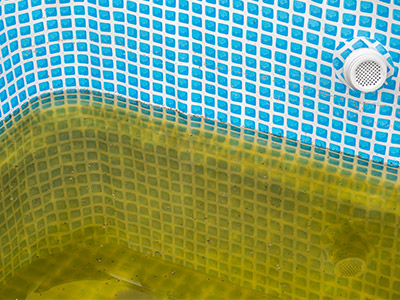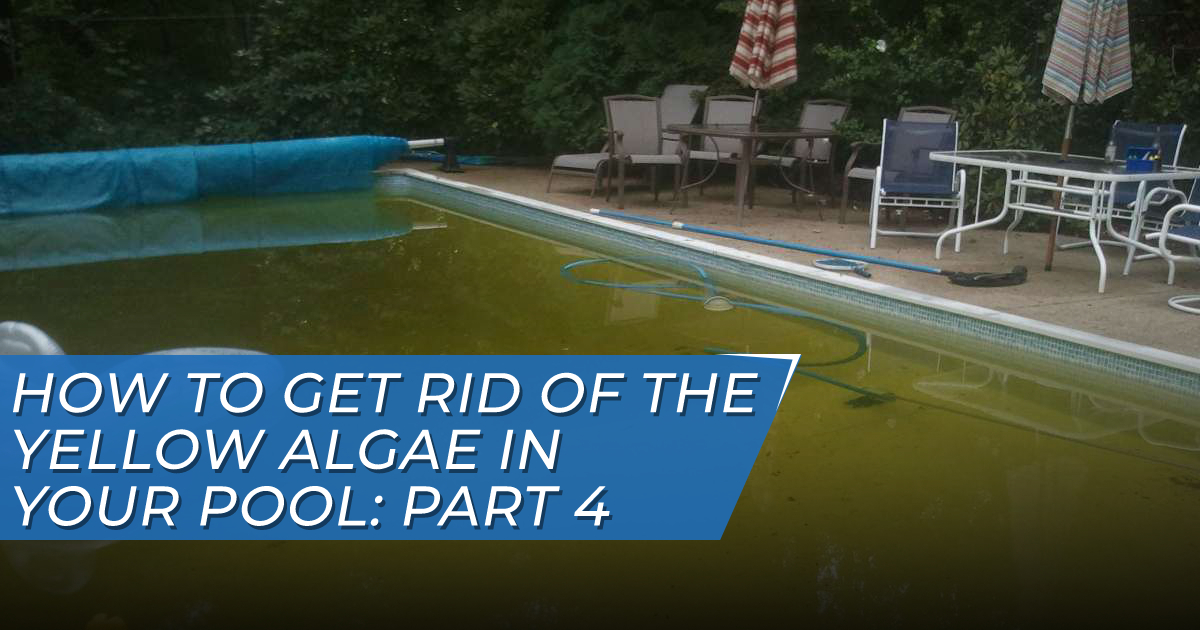How To Get Rid Of The Yellow Algae In Your Pool: Part 4
It’s not a stain, it’s not a patch of sand, it’s not dirt. It’s yellow algae (or mustard algae), a kind of organism that comes out of nowhere and is determined to stay. It tends to cling to the walls and stairs, especially in the shade and is quite hard to spot until it’s already firmly entrenched. That’s why, if you’ve got yellow algae in your pool, you already have a problem – and it won’t be easy to get rid of it. But don’t worry: it’s not impossible.
Related Article: How to Maintain a Swimming Pool: Getting the Chemistry Right
What to Do about the Yellow Algae in Your Pool
 Yellow algae are also commonly known as mustard algae, precisely because of their mustard-yellow coloring. This is also what makes them hard to detect: in the beginning the patches are small and hard to see, looking rather like a discolored spot or stain. They tend to appear at the bottom and extend upward.
Yellow algae are also commonly known as mustard algae, precisely because of their mustard-yellow coloring. This is also what makes them hard to detect: in the beginning the patches are small and hard to see, looking rather like a discolored spot or stain. They tend to appear at the bottom and extend upward.
When you catch on to the existence of yellow algae in your pool, the sandy-colored spread has most likely developed a couple of annoying characteristics: it’s clingy and, up to a point, chlorine-resistant. They have, in fact, become quite a bit of a problem. And how you take care of the problem determines whether they come back or not.
Understanding Why Yellow Algae has Appeared
Yellow algae are southern creatures, so Floridians often have the unpleasant surprise of finding them at the bottom of their pools. There is not much you can do to prevent the appearance of yellow algae in your swimming pool: they are brought in by members of your family on pool equipment, toys, shoes or swimsuits, swept in by the wind, carried by the rain etc.
If you take good care of your pool, though, they should be unable to survive and thrive. If they do appear and multiply, it’s a sign something is wrong with your water chemistry, filter and pool maintenance. In other words, to be blunt, it’s your fault.
Is Mustard Algae Dangerous?
Green algae are slimy and unpleasant; black algae are not slimy but can harbor bacteria. The yellow algae are more like the latter variety: while they don’t normally strike the swimmers as unpleasant in themselves, they can become a host to a variety of microbes and bacteria. Here too, E.coli is the worst offender.
In addition to that, yellow algae can raise pH levels and cloud the water if left untreated for too long.
How to Prevent the Appearance of Mustard Algae in Your Pool
- Run your pump and filter for at least 8 hours every day.
- Use algaecide at least once every two weeks.
- Brush and vacuum your pool on a regular basis. Consider using a robotic pool cleaner.
- Make sure your chlorine levels never fall below 1 ppm; preferably keep them above 2 ppm.
- Keep pH levels between 7.2-7.6.
- Shock your pool on a regular basis, preferably once a week.
- Keep your equipment clean, from the filter to the pool toys.
Related Article: Proper Water Balance and Testing
How to Get Rid of the Yellow Algae in Your Pool
When it comes to getting rid of algae, there is little variation in what you have to do, but there’s quite a lot of work. In the case of yellow algae, here is what you should do to not just get rid of those already there, but also prevent them from reappearing.
- Make sure the filter is in good shape. That’s just to make sure it will be able to handle the extra work coming its way. Set it to “waste”.
- Vacuum the pool. Yellow algae are small, so if you just use your filter, they can simply settle in there and resurface later on.
- Brush and scrub the pool. Since yellow algae live along the walls and stairs, pay special attention to brushing and scrubbing, especially the mustard-yellow areas.
- Shock the pool. The recommended dosage is higher than that for regular shock. When you shock your pool for maintenance, you should be using one pound per 10,000 gallons of water. When you’re on an algae-killing mission, use three pounds of pool shock for every 10,000 gallons of water.
- Shock the pool – again. Don’t forget to wear gloves and keep everyone away from the area. Super-chlorination and algaecides are not skin-friendly, to say the least. It’s advisable to shock the pool late in the evening and have the filter running through the night and all the next day.
- Brush again. No, it’s not too much. In fact, you can do everything three times just to be on the safe side.
- Clean your filter. After what’s been going on, your filter is going to need good brushing and cleaning.
- Test the water chemistry. After a few days of shocking and brushing repeatedly, you will want to make sure you’ve gotten the right balance. Chlorine above 2% and pH levels around 7.4 should keep you safe from now on.
- Set a maintenance schedule. Once everything has gone back to normal, make sure this never happens again. It’s just too much work! Set a schedule that tells you when to do what just to keep your pool water clean and swim-ready.
If you don’t feel up to fixing the problem, contact us and we’ll take over. With our team of expert technicians and pool stores in New Tampa, Lutz, and Land O’ Lakes for the residents of Wesley Chapel, Pebble Creek, Tampa Palms, Odessa, Seven Springs, Lake Fern, and others, that gives us direct access to fair prices and top quality. We’ll know exactly what to do to get you the best pool cleaning service at the most affordable rates.
Be sure to check out the rest of our blogs in this 5 part Pool Algae Series.
How To Get Rid Of The Algae In Your Pool: Part 1 The Basics
How To Get Rid Of The Green Algae In Your Pool: Part 2
How To Get Rid Of The Black Algae In Your Pool: Part 3
How To Get Rid Of The Pink Algae In Your Pool: Part 5

